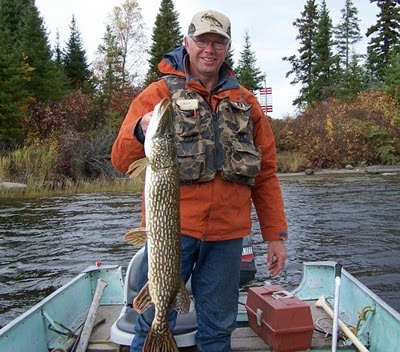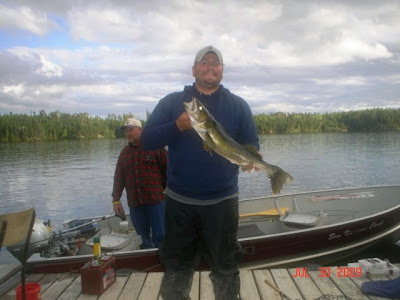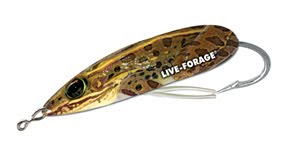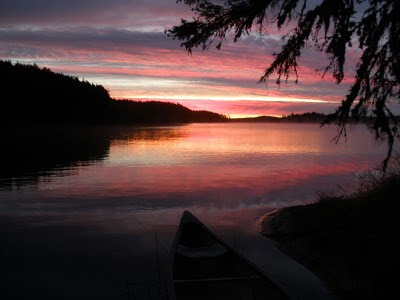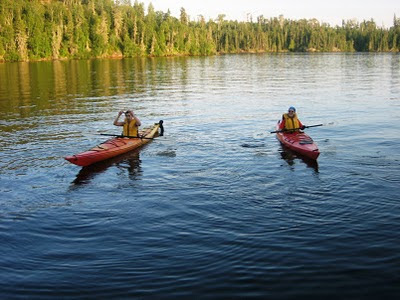
This was updated February 24, 2024
Here's a list of what most fishermen bring when they come to our fishing lodge on Red Lake, Ontario.
I've added a couple of things that I personally think are important.
Clothing
By bringing a few versatile things you will be prepared for anything Nature might throw at you. I can't emphasize enough the importance of this first item:
This is more important than your fishing equipment! You are far better off to have great rain gear and poor fishing equipment than vice versa.
2. Waterproof boots (rubber or Gore-tex type). Although hunting-style boots are the best, an inexpensive but quite effective alternative is overshoes such as Totes. They're also lightweight and fold into a small space.
You need to be completely waterproof, from your head to your toes. Our summers are almost always gloriously warm and sunny but you need to be ready for the worst just in case.
3. T-shirts, underwear and socks for each day you will be on your trip
4. Two pairs of jeans or other fishing pants
If you bring pants with the zip-off legs you can skip the next item
5. Two pairs of shorts
6. A swimsuit!
7. Long underwear!
8. Tuque a.k.a. stocking cap or knitted winter cap or wool cap
9. Neoprene gloves (Optional)
10. Wide-brimmed hat or baseball cap
11. Light jacket or sweatshirt
12. Heavy sweater (an even-better alternative is a down jacket. Cabelas often has these on sale for $29. They will stuff into a tiny space in your luggage and are the ultimate in warmth.)
13. Sneakers or light hiking boots
14. Two flannel or other shirts
No matter when you come, from mid-May to the end of August, the weather is probably going to be wonderful. You'll feel great in jeans and a flannel shirt or t-shirt with a jacket for mornings and evenings.
If it gets warm, wear your shorts. If it gets hot, put on your swimsuit and go for a dip in the lake.
If you somehow get wet, you've brought an extra set of dry clothes. Hang up the wet ones to dry in the cabin or outside.
If it gets unexpectedly cold, put on your long underwear, your heavy sweater or down jacket and most importantly, your breathable rain gear, plus your neoprene gloves which stay warm even when wet and your tuque (wool cap). With the exception of the neoprene gloves, this outfit is what I wear all winter. The key is breathable rain gear which cuts the wind but doesn't make you sweat.
Fishing equipment
If you have everything on this list you would be totally prepared but you can get by with less as well. If you click on the highlighted words it will bring up more information about each of these items.
Two should be medium-action, 6-to-6.5 foot rods. You only need one but have two in case you break one. The third is an ultralight spinning rod. (Optional) It's a blast for catching walleye in calm conditions.
These should all fit in a cheap, conventional plastic rod case. If your rods are two-piece this rod case won't be more than 3.5 feet long and will conveniently fit in your car truck or won't be classed as oversized luggage by airlines. You can also bring the rods loose but they stand more chance of damage that way.
2. Two reels plus the reel for the ultralight. The most versatile outfit is the medium-weight spinning reel which is made for 8-12-pound test line. Spool them with 8 pound line if you like to cast or jig, 10-12-pound if you like to troll. You could, of course, have one rod set-up for casting and the other for trolling. The ultralight spinning reel should have 4-6 pound line.
(See Which is better, monofilament or braided line)
3. An extra box (spool) of line.
5. Six 12-pound thin wire leaders (handy for small lures but optional)
6. A
portable depth-sounder/fish finder for each two people (for each boat) and an extra set of batteries. (This is optional but most groups have them. Use it for fishing at the proper depth, not for "finding" fish.)
9. 30 leadhead
jigs in the following sizes: dozen 1/4 oz, dozen 1/8 oz, three 3/8 oz, three 1/2 oz
11. Lead sinkers: six 1/4 oz, six 1/2 ounce, six 3/4 oz, one pack split shot
12. Slip bobber with rubber stops
13. Plastic bobber
14. Assorted-size single hooks for bait fishing. These should be small for walleye. If you plan on fishing with
dead bait for northern pike, we recommend 5/0 circle hooks.
15. Six stick baits such as Rapala etc., shallow and deep running, 4-6 inches in length (These are the most expensive lures and not necessarily any better than spoons, spinners and jigs; so, you can scrimp here if you want.)
16. Two dozen plastic twister tails for jigs and Johnson spoons: 2.5" for 1/8 oz jig, 3" for 1/4 oz jig, 4" for 3/8 oz jig
18. Six dozen worms/leeches or combination per person per week
20. Hook sharpener or stone (One per boat)
21.
Prism tape in various colors for changing lure colors
22. Nail clippers for trimming line
Miscellaneous items
1. Bottle sunscreen (the summer sun here is more intense than what you are used to)
3. Flashlight
4. Comfortable
life vest. We supply these at Bow Narrows Camp but if you bring your own and it fits your build comfortably you will be more inclined to wear it all the time. Parents should always bring the proper-sized vest for their young children and insist they wear it any time they are outside.
5. Sun glasses with polarized lens (neck strap for these is also handy)
6.
Refillable water bottle (All of the water from Bow Narrows Camp taps is delicious, crystal clear, filtered, safe drinking water from our water treatment plant. When you bring a water bottle instead of bottled water you are doing the environment a big favor.)
7. Camera and extra battery
8. Binoculars (optional). Handy for spotting wildlife.
9. Small radio (obviously optional but we suggest tuning in to CBC Radio One 90.5 FM for some really thought-provoking, discussion-starting programs as well as Northwestern Ontario news and weather.
10. Passport!
11.
Ontario Outdoors Card (if you fished in Ontario the last two years you would have been mailed this. If not or if you forget yours you will need to get one. Applications come with your fishing license which we have at camp. The cards cost $9.
12.
Boater Safety Card (optional). All Canadian boaters have one now. You can get one by taking a course on-line and it is good for life. If you don't have one you can just fill out our boat-rental form which serves as a one-time boater safety card.
13. Spare keys for your vehicle. Give these to a buddy to safeguard.
14. Pocket knife. If you plan on cleaning your own fish out on the rocks for shore lunch, then also bring a fillet knife. However, since at Bow Narrows Camp we expertly clean all your fish and remove all the bones, you don't really need a fillet knife. You can also have us clean your fish that you take out for shore lunch.
15. Chapstick
16. Rod tip repair kit. This includes a couple of replacement eyes and glue.
17. Duct tape or other brands. One roll per group is plenty.
18. WD-40. These come in small pen-size containers that are ideal for lubricating reels.
19. First-aid kit. One per group.
20. Personal medicines plus pain reliever, cold or allergy relievers, upset stomach treaments and diarhhea medicine just in case someone comes down with a cold or flu on your trip.
21. Medium to large cooler if you plan to take fish home. One per 4 people.
22. Small cooler with refreezable ice pack for keeping drinks and/or bag lunch cold in the boat. Depending on the size you may only need one per boat.
23. Eight-inch Crescent wrench. This is large enough for propane tank fittings and can also remove sparkplugs, etc.
24. Package of plastic zip ties of various lengths.
That is a fairly complete list. If readers have other things they find handy or necessary, please leave your comment and I'll be sure it is printed.
Click to go back to our website:
Click to see the latest on the blog:
www.bownarrows.blogspot.com
